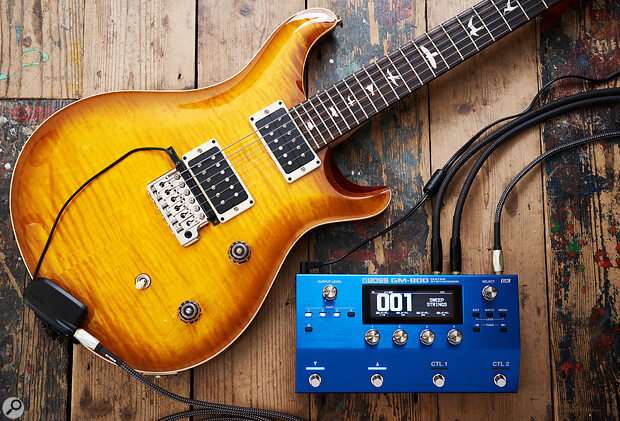It’s nearly half a century since the first guitar synth became available commercially — and, boy, have they come on a long way since then!
Boss’s GM‑800 guitar synth may look a lot like their SY‑300 — both models have roughly the same form factor, colour and general control layout — but they’re very different beasts. Based around the latest generation of pitch‑tracking technology, the new GM‑800 follows the paradigm of the latter‑year GR series, specifically in that it uses a divided guitar pickup to send the individual string signals into a digital signal processor that extracts the pitch and velocity information from the notes before using it to trigger the kinds of sample‑based sounds you might expect to find in a keyboard synth. The GM‑800 can also output MIDI to control an external MIDI synthesizer or sound module, and accepts MIDI in, not only for deep parameter control but also to allow it to double as a MIDI sound module itself.
Overview
Before going further it should be noted that the connection system between the pickup system and the GM‑800 no longer uses a 13‑pin DIN connector. Instead, it employs a serial communication system that works with a standard TRS jack cable. The new compatible pickup is the GK‑5, but for those with existing GK pickups or guitars with compatible pickups built in, an adaptor called the GKC‑AD converts from the older system to the new one. This takes the form of a utilitarian metal box with a 13‑pin GK input, a serial GK output and a separate jack output that carries the standard guitar sound. Status LEDS show power and connection; power comes from an included inline adaptor. Until a connection is established between the GM‑800 and the GKC‑AD, a green LED flashes but remains solidly lit once a connection is made.
 The GM‑800 launch was accompanied by that of a new GK pickup system that uses a serial connection over a standard TRS cable. The pickup is available separately, and you can also buy adaptors for older pickups.
The GM‑800 launch was accompanied by that of a new GK pickup system that uses a serial connection over a standard TRS cable. The pickup is available separately, and you can also buy adaptors for older pickups.
Setup, accessed via the Menu and Page buttons, includes fine‑tuning your GK pickup options. First you select which type of pickup you have — this may be a third‑party instrument, including those with piezo divided pickups — then you need to adjust the sensitivity for each string so that they all produce a similar output for a given picking force. There’s a long list of pickups from which to choose, including third‑party systems by Graphtech, Fishman and more.
It’s very important to get the pickup setup right, as this will affect how well the instrument responds to your playing style. Set the sensitivity too high and not only will you lose out on some dynamics when picking hard, but there’s also an increased risk of triggering unwanted sounds from fingering noise. On the other hand, if you set it too low, you might not be able to reach the maximum level even when picking hard. To help with setup, a set of bargraph meters show you how much output you get from a string as you pick it. The general aim is to ensure that your normal hard picking gets the meter close to maximum without actually reaching it. There are also setup options for selecting guitar or bass, the latter requiring a GK‑5B pickup or an earlier GK bass pickup plus a GKC‑AD adaptor. As some users may have more than one GK guitar, its is also possible to create and save several different pickup settings.
The output can be mono or stereo and there are internal settings to voice the sounds for either a regular guitar amp or a full‑range speaker system (such as a keyboard amp or PA feed), which is of course preferable. The left output also doubles as a headphone output and in addition to the 5‑pin MIDI in and out...
You are reading one of the locked Subscribers-only articles from our latest 5 issues.
You've read 30% of this article for free, so to continue reading...
- ✅ Log in - if you have a Subscription you bought from SOS.
- Buy & Download this Single Article in PDF format £1.00 GBP$1.49 USD
For less than the price of a coffee, buy now and immediately download to your computer or smartphone.
- Buy & Download the FULL ISSUE PDF
Our 'full SOS magazine' for smartphone/tablet/computer. More info...
- Buy a DIGITAL subscription (or Print + Digital)
Instantly unlock ALL premium web articles! Visit our ShopStore.


